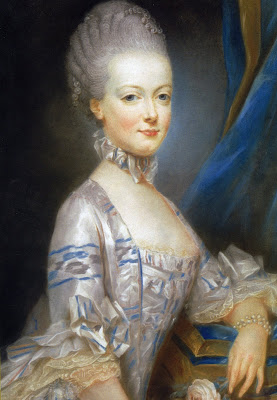 To French aristocrats, a tightly corseted body represented "the norms of stiffness and self-control" expected of the ruling caste. Marie-Antoinette's position required her to wear a form of corset called a grand corps. This more rigid form of corset was the "mark of supreme distinction". Only France's greatest princesses had the right to wear this undergarment on a regular basis. Other noblewomen were allowed to wear it only on the day of their presentation at court and after that, only at specially designated formal functions. This corset was stiffer than a regular corset and made breathing, eating and even moving one's arms difficult.
To French aristocrats, a tightly corseted body represented "the norms of stiffness and self-control" expected of the ruling caste. Marie-Antoinette's position required her to wear a form of corset called a grand corps. This more rigid form of corset was the "mark of supreme distinction". Only France's greatest princesses had the right to wear this undergarment on a regular basis. Other noblewomen were allowed to wear it only on the day of their presentation at court and after that, only at specially designated formal functions. This corset was stiffer than a regular corset and made breathing, eating and even moving one's arms difficult.The grand corps was described by the Marquise de La Tour du Pinto be "a specially made corset, without shoulder straps, laced up the back, but tight enough so that the lacings, four fingers wide on the bottom, allowed for a glimpse of a chemise of such fine batiste that it would be readily apparent to everyone if one's skin underneath was not sufficiently white...The front of the corset was laced, as it were, with rows of diamonds."
Marie Antoinette did not like wearing the grand corps, especially as the corsets she was used to wearing in Austria were far more flexible. A few months after arriving in France, she rebelled against wearing the grand corps and since she was thin enough to wear her gowns without this tortuous undergarment, she went without. This rebellious act was considered a breach of etiquette of considerable proportions. The court took to whispering about Marie Antoinette's misshapen waist and right shoulder and this gossip was repeated far beyond the court eventually reaching her mother Marie Theresa, Empress of Austria and Queen of Hungary. It took diplomatic intervention by the Austrian ambassador to convince Marie Antoinette to resume wearing the grand corps on a regular basis.
Later in her life, Marie Antoinette took to wearing a thin white chemise dress with a ribbon sash. This airy, ruffled informal dress did not require a corset and was widely copied.
Sources:
Queen of Fashion
Marie-Antoinette Style
Corsets and Crinolines
The Corset, A Cultural History